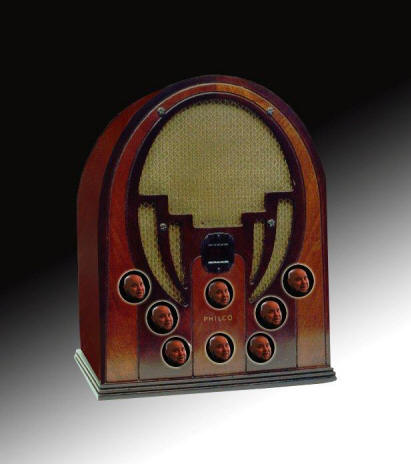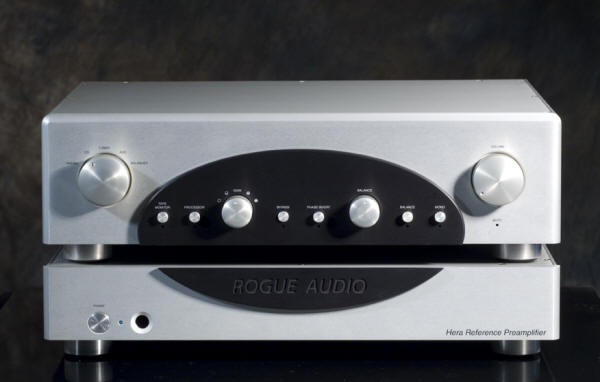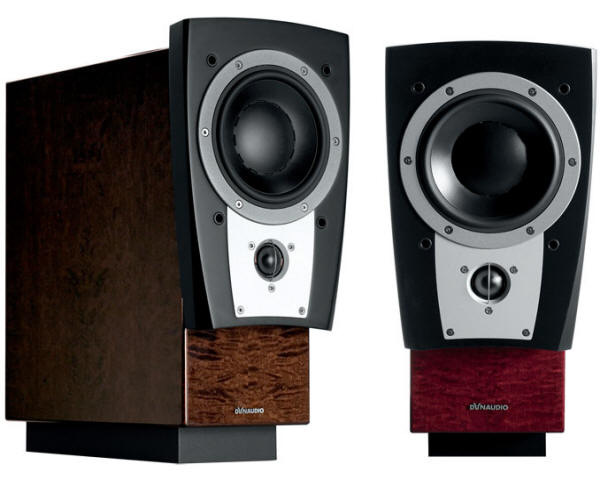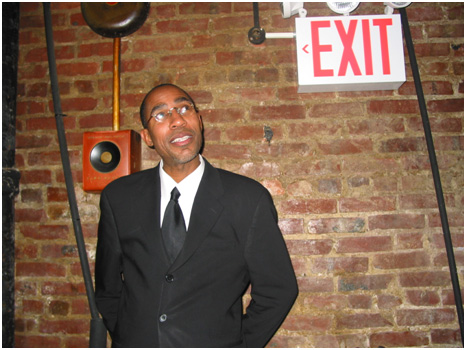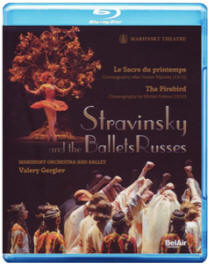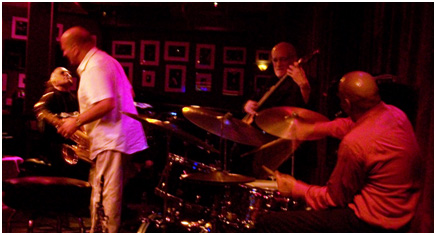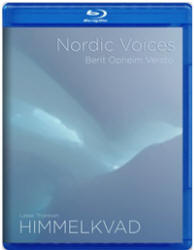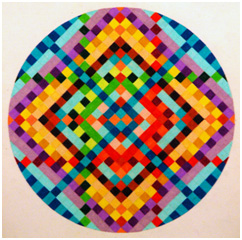|
You are reading the older HTML site
Positive Feedback ISSUE 64
Radio Free Chip -
The Upgrade Company Signature Mod of the
Oppo BDP-95 Universal Blu-Ray Player
Relativity. To Albert Einstein, it suggested a relationship between observers and observed. To audio freaks, it depicts the endless search for more detail and dynamic range; greater transparency and a higher signal to noise ratio; enhanced sound staging; and a level of resolution and believability on par with the reproductive capabilities of their other components. Relativity thus suggests something of the listener's aural perspective; the merits of each and every component in the audio signal chain; bang for buck—and the fundamental audiophile principles of diminishing returns. Diminishing returns, say you? Indeed, the received wisdom which holds that as one spends more and more money, the proportional degrees of enhancement grow smaller and smaller. Of course, those purportedly "diminishing" degrees of enhancement are often the most profoundly moving and musically significant. Obviously, the degree to which prospective consumers are inspired to pay for those incremental enhancements is strongly influenced by one's financial constraints. Still, all things being equal, the relative quality of all their other components in the signal chain is an even bigger concern, as you don't want to simply toss money against the wall to see what sticks. If you have assembled an audio system that is profoundly revealing, then investing in higher resolution components should enable you to transcend the gear itself and achieve an even deeper sense of immersion in the music. Whereas if your gear was assembled in a more parsimonious manner—the listener being ever mindful of the need to apply financial prudence—then the degree to which one makes their compromises work is measured by how pleasing a musical balance they achieve. Introducing proportionally more sophisticated components into the signal chain may ironically tell you way more about your system than you really need to know… relative to your experience of the music itself—which should be the ultimate end game. [Cough.] Well, where then to put your money (other than where your mouth is)?
Audiophiles tend to differ on where best to invest. A compelling case can be made for any and all of the components in the signal chain; including gastrointestinal and neurological tweaks involving the connective tissue of speaker cables and interconnects; and the purity of power sources as regards after-market AC cords, not to mention sundry filtering and balanced power schemes. However, years ago J. Gordon Holt suggested to me that such enhancements should only come into play at that point where the listener has assembled a well-balanced set of quality components, and attained a coherent acoustic balance and purity of midrange resolution. In any event, I have found that as one chips away at sources of noise and interference, the closer a listener comes to an authentic sense of how good all of the components in your signal chain may actually sound—bringing you that much closer to the music. Okay, so where to prioritize? For some people, while more power is not always necessary—relative to the size of the room and the speaker load being presented to the amp—in my admittedly small window of experience, it is generally welcome in terms of dynamic headroom and transient realism (we recognize that this is a hot-button issue to the SET-sect, and God bless, y'all are welcome to argue from your own perspective, but this is how I experience it). Then there are issues involving ROOM COUPLING, perhaps the most overlooked and underappreciated aspect of system voicing; how your loudspeakers interact with the amp/pre-amp, and most critically, how they COUPLE WITH THE ROOM ITSELF, can contribute significantly to the overall voicing and impact of your audio system. Still, all things being equal, when contemplating the ten or so basic commandments of high resolution audio, one invariably returns anew to this fundamental principle: YOUR AUDIO SYSTEM IS ONLY AS GOOD AS ITS WEAKEST LINK. And inevitably, this brings us back to our source components, be they in the analog or digital domains. ULTIMATELY, YOUR SYSTEM IS ONLY GOING TO SOUND AS GOOD AS YOUR SOURCE COMPONENTS. Having said all that, I must confess that given the nature of the aural journey I have undertaken, I assembled my system in a rather bass-ackwards manner—and it took me a long time to finally settle on a digital front end component worthy of the rest of my system as it has evolved over the past 5-10-15 years. Cut to the chase…
Because while I have metaphorically danced with many beautiful women in my day, I have finally at this late date settled down to a blissful state of front end audio monogamy: because the Upgrade Company's Signature Edition of the Oppo BDP-95 Blu-Ray Universal Player ($2399) sounds that damn good, and its enhanced set of modifications offer a dramatic uptick in value and performance—commensurate with far more expensive disc players, universal and otherwise. Which begs the question: how good is what the Upgrade Company (http://www.upgradecompany.com/) represents as its "audio/video/motherboard/power supply Signature Edition upgrade including extensive proprietary RFI & EMI shielding and dampening?" Well, consider this: The Upgrade Company literature asserts that they are not only "one of the largest OPPO authorized dealers in terms of sales volume… [they are also] the ONLY aftermarket mod firm approved by OPPO to become a factory authorized dealer." Additionally, the Upgrade Company affords buyers an unconditional guarantee: try out The Signature Edition of the Oppo BDP-95 in your system for two weeks, and in the event that you somehow find it lacking in any way, send it back for a stock unit and a full refund. A bold challenge, indeed, that is of particular interest to seekers after high resolution nirvana, considering the degree of acceptance the cost-effective, lovingly engineered stock Oppo BDP-95 has found among apple-cheeked consumers and snarky audiophiles alike; it is the people's choice, an audiophile-grade Universal Player benchmark—the Model T Ford of modern 2-channel and home theater applications. We shall return anon to this theme, but first some more parenthetical throat-clearing on the significance of front end audio verity, as I have come to understand it from personal trial and error.
On the analog front, while I am heavily invested in my old LP collection (on the order of around 7000 discs), my front end rig is relatively humble (by cost-is-no-object audiophile community standards): still, my present configuration—comprised of a Rega Planar 25 turntable with an RB600 tone-arm, a Grado Statement Master moving coil cartridge, a Ringmat 330, a Signal Guard II isolation stand, connected to a Rogue Stealth Phono Stage with a pair of JPS Labs Superconductor 3 interconnects and an Acoustic Zen Absolute AC cord—would prove plenty righteous for most carbon based life forms. Still, in the evolution of this scribe's system, the digital front end has long been the poor sister of my audio family, despite the fact that some truly superb players have passed through my portals of penance over the years (from the Sony SCD-777ES SACD Player that I evaluated for Stereophile, through a McCormack UDP-1 Deluxe Universal Player I reviewed for 6Moons, and the Luxman DU-80 Multi-Standard Music Player I enthused upon at length for Positive Feedback back in issue #42). The Luxman was particularly pleasing to a tadpole that long ago broke his cherry on Luxman gear in the ‘80s. With its richly detailed levels of resolution, not to mention the spellbinding mojo of their midrange (thanks to a set of proprietary DACs), the DU-80 was alas, well out of my price range at the time, and so inevitably there came a day of reckoning when, pausing only to wipe a solitary tear from my eye, I put on my big belt buckle Elvis costume and sang me a few choruses of "Return To Sender." James Burton, ladies and gentlemen, thank you very much. Well, now that I've had the opportunity to live with the Upgrade Company's Signature version of the Oppo BDP-95 for a while, I've had to cue the conductor to change my tune… I now find myself lip-synching Etta James' "At Last." In a way, I was lucky not to be able to afford the Luxman, much as I had grown attached to its aural charms, because time doesn't merely march on in the digital domain, it veritably gallops. Never you mind the burgeoning world of computer audio, which at the moment would appear to offer the most potential for substantive growth in a saturated high end audio market—both among audio dealers and audio fans. That is to say, after half a lifetime of side-stepping the visual aspects of my musical compulsion, audiophile systems such as my own now have the potential to integrate even more effectively with video (even if only in the 2-channel, proscenium arch domain). However, with such progress comes collateral damage, and given the growth of HD TV, 1080p and the Blu-Ray format, some of the finest universal players on the market suddenly became, if not obsolete, surely compromised in terms of the great leaps forward the Blu-Ray format offers—not for high definition video resolution, but audiophile sonics. The problem is that manufacturers and consumers alike are rather gun-shy about committing to any new formats, the memories of the DVD-A experience (which arrived more or less dead on arrival) still fresh in their minds. Then you have to account for the ascendancy of iPods and the entire downloading culture, let alone the burgeoning reality of DACs and computer audio as it rapidly overtakes the old world culture of discs and disc players. Still in all likelihood, even were designers and old school sonic pilgrims to conclude with Biblical certitude that Blu-Ray doesn't simply represent the latest flavor of the month, audiophiles will likely disdain the supposed enhancements of the Blu-Ray format as yet another fly-by-night, here-today-gone-tomorrow gimmick to divest us of our money in the quest for some of those aforementioned ever-diminishing returns; a chorus of We Won't Be Fooled Again by the Who suddenly appears on my internal jukebox. And with the exception of a few high end companies such as Denon and McIntosh, neither audiophiles nor manufacturers have been in any great hurry to adopt the Blu-Ray standard until they see how the market shakes out. Speaking only for myself—having had the opportunity to check out both Blu-Ray video, as well as dedicated Blu-Ray audio—I am quite impressed with the present reality and excited about further possibilities. Blu-Ray is not simply a gimmick, but represents a great leap forward as a high resolution audio format. Furthermore, I am quite pleased to have found a Universal player which allows me not only to enjoy my CDs as never before, but to optimize performance from my SACDs, dedicated DVD-V audio and video discs as well as the odd DVD-A and sundry Blu-Rays (such as master engineer Jim Anderson's dedicated Blu-Ray Audio re-mastering of Patricia Barber's iconic audiophile standard, Modern Cool). Likewise, for this particular Pilgrim, the Swiss Army Knife qualities of a Blu-Ray Universal Player are highly appealing. You see, having swapped out all manner of components in my signal chain over the past 15-20 years, in my dotage I have increasingly grown to appreciate the virtues of…simplicity. In my 14 x 20 x 10 reference studio, as my system has evolved, my Dynaudio Confidence C1 loudspeakers are about four feet in front of the long wall; roughly two-three feet from acoustic panels on the side walls; six feet apart from tweeter to tweeter; and seven feet from my sweet spot in the near field on a straight back chair I inherited from my mother—which is both a good height relative to the woofers and tweeters, and far kinder to my back then the crappy couch which it replaced (that was positioned much further back in the room nearer to the radiator and our northern exposure).
My two-shelve amp stand is in the middle just behind the speakers, with a large wooden table behind that, upon which my voltage regulator and a pair of balanced power isolation transformers sit. And surprise-surprise, my 42-inch Panasonic TC-P42G25 Plasma TV (purchased at the very end of 2010) is parked in between the speakers on a wheeled but very stable old Salamander TV stand, minus any sort of cable-TV or surround sound extras—two-channel proscenium arch all the way, baby, dedicated to audio and high-resolution video discs exclusively (I do my industrial TV viewing on a simple device tethered to my cable box next to my computer desk in the adjoining room). My dual-equipment racks are within arm's reach on the immediate right of my listening chair on the short wall, hooked up to my Rogue power amps via a balanced 15-foot run of JPS Labs Superconductor 3 Balanced Cables. As such I have neither the room nor the inclination to trouble myself with things that undermine the relative simplicity of my set-up, such as separate transports and DACs or dedicated CD-only playback solutions, minus the high resolution video options. Ergo my attraction to the Swiss Army Knife attributes of a good Universal Player, which are largely disdained by those audiophiles who hold that combining video functions with audio functions in one chassis, let alone including such marginal high-resolution formats such as DVD-A and SACD, precludes one's ability to do a single thing really, really well—play compact discs. And so, they disdain the universal player, let alone the Blu-Ray Universal Player. Before the tail end of 2011, I was making do with a discontinued Lexicon RT-20 Universal Player I happily snapped up on Audiogon for 750-smackers, still highly prized by cost-conscious audiophiles (especially when contrasted with its original MSRP of $5000). And for those who steadfastly refuse to become ensnared in the Blu-Ray upgrade game, it remains a solid investment. Looking back upon the past year or so, it occurs to me that—beginning with the final inclusion of a 42-inch plasma some dozen years after I first lusted after that nascent technology at a Los Angeles High End Audio Show (the price then, $11,000… by the end of 2010, $775)—I basically swapped out most of my system in an attempt to initiate a final set of upgrades before more or less throwing up my hands and going ENOUGH'S ENOUGH. At some point one simply has to say…enough. Cumulatively speaking I tweaked my Rogue M-180 mono-blocks with a significant KT-120 tube upgrade; I discovered the aural attributes and sheer dynamic power of the hybrid Rogue Medusa stereo amp; and after saving up for what seemed like an eternity, I was finally able to purchase my dream pre-amp, the two chassis, 6H30-equipped Rogue Hera II, which counts amongst its many aural attributes, separate tape monitor and processor loops (with which to connect both my Alessis ML-9600 Digital Recorder and tubed Manley Massive Passive Parametric EQ). Additionally, the Hera II also offers a fully balanced input, and when outfitted with a sweetly resolved, remarkably detailed and dynamic new Absolute Copper Balanced Cable from Acoustic Zen, I was able to achieve another 3dB of S/N and enhanced low level detail, with believable dynamics and a spooky sense of venue—allowing the speakers to simply disappear as I floated a soundstage of breathtaking depth and musical realism. And all things being equal, after several months of burn in and critical listening, I have come to the conclusion that as superb as every element in my system has come to be, the missing link, the critical, make-or-break component that put my system over the top and allowed me to finally ascended the lofty peak of Mount No-Compromise, not only turned out to be the most cost-effective component in the mix, but surprise-surprise, was THE SOURCE COMPONENT. Like, duh. And that slam dunk of a source component was the Upgrade Company's cost-effective Signature Edition of the Oppo BDP-95. It all began well after I'd gotten adjusted to the presence of the plasma TV in the middle of my soundstage. After checking out the DVD/Blu-Ray demos at some retail stores, I began to re-think my next step in terms of a high-resolution digital front end.
All it took was some encouragement from Positive Feedback On-Line mandarins David Robinson and Dave Clark, who were so enthusiastic about the audio and video qualities of the Oppo line, that sight and sound unseen, I plunked down coin on a stock BDP-95—and was I ever smiling. Right out of the box, while their midrange attributes initially struck me as comparable, the Oppo had far better dynamics and more tautly articulated bass than the Lexicon with a smoother, more fleshed out high end; a more capacious soundstage with better image specificity; greater transparency and transient realism. And over time the BDP-95 got nothing but better, as the midrange flexed up and fleshed out. In discussing the Oppo's attributes with PFO Editor David Robinson, he assured me that I would be hard-pressed to match the thousand dollar BDP-95's musicality short of a universal player the likes of the $6000 Esoteric DV-60. Cut to a close-up of the author… happy-happy… fade to black, cue end credits. How could it get any better? Well, funny you should ask. Because somewhere down the line, given my enthusiasm for the BDP-95, my PFO editors wondered if I would have any interest in checking out the Signature Edition of the Oppo BDP-95 from the Upgrade Company. I was a little hesitant at first, because…well, because I had grown very fond of the stock Oppo, and I was rather conflicted about checking out something I might like better, let alone a lot better, money not growing on trees, and knowing that in my heart of hearts, I was aurally lustful, and liable to reach for my credit card at the slightest provocation—given to a wandering ear metaphorically speaking when the next pretty girl rounded the corner and shook her booty in my general direction, only 3dB down at 22HZ….talk about low end. Somebody stop me. Also, before I got to know David Schulte, head honcho and high priest of The Upgrade Company, I found myself a little wary of the evangelical fervor with which he articulated his pride of authorship, seeing as how I am empowered by Aural Pilgrims I have never met to be an honest broker; to be wary of large-sounding claims; to fairly assess the absolute performance attributes and bang for buck value of gear my readers do not have the luxury of living with for an extended period of time. And so, when I first plugged in the Signature Edition of the Oppo BDP-95, I had yet to take the full measure of the Right Reverend Schulte as a cat, nor did I particularly care to—though in time, as our extended interview makes plain, I came to understand that while David tends to speak in the highfalutin absolutes of a true believer before the cross, he comes by it honestly, having been a full-blown audio geek since he was nine years old; an inveterate tinkerer and inventor who fell in love with cool gear and was determined to find out what made the best good, and how to make the good even better.
Wary as I was out of the gate, I retreated to my cone of solitude, plugged in the Signature Edition, took some cursory mental notes as to what subtleties I noticed straight away—refusing to draw any hasty conclusions—and proceeded to simply play music, play more music and burn, Burn, BURN that motherfucker in for hundreds and hundreds of hours more than a consumer might enjoy on a two week qualifying audition. Not to mention how the initial Upgrade Company info sheets I received spoke of Black Gate capacitors in the signal path, which have been held in very high esteem by audiophiles and which purportedly required an extensive burn-in on the order of 600-800 hours to reach their full audio potential. Well, clearly you're not going to achieve that level of burn-in over the course of two weeks; and subsequently (as you may glean from our interview), Schulte has come to distance himself from the cachet of hip parts in general, and Black Gates in particular, pointing to a series of proprietary techniques he evolved over time as having a far greater impact on the overall performance enhancements. In any event, I took my sweet damn time burning the Signature Edition in to make sure I was experiencing the Full Monty before undertaking any conclusive A/B comparisons. And before I undertook any such comparisons, I unplugged the Signature, let it cool off, and gave the stock Oppo a good week of playing time before inviting over any friends, Romans, countrymen to lend me their ears; seeking to render on to the stock Oppo that which is stock and unto the Signature that which a consumer has a right to expect for another $1399—basically the price of a good after-market AC cord and a set of hip interconnects. At this point, you may rest assured that I listened extensively to all of my favorite reference discs, and some new ones as well; after a while, I must confess, I arrived at my final conclusions with great gusto, and thenceforth spent a considerable amount of time simply relishing the glory of my audio system as I fleshed out and burned in all its new components, and came to realize that while the Signature Edition of the Oppo-BDP-95 was the most humble component in terms of its price point, in many ways it was contributing the most profound impact of any gear in the signal chain. What's more, while the Upgrade Company's Signature Edition mod of the Oppo BDP-95 comes in at $1399 over the suggested list price, the actual cost pales relative to the enhanced performance attributes it conveys to your digital front end—and the system as a whole. Because for starters, while there was a palpable midrange lushness to the Luxman DU-80 that remains engrained in my aural bone marrow, the midrange attributes of the Signature Edition are nothing to sniff at, and in every other way shape and form, in my reference system—both before and after I swapped out key components—the Signature Edition of the BDP-95 performed at a significantly higher level than a component that back in the day retailed new for over eight thousand dollars more than the Signature Edition of the Oppo. How so? Well, its stunning midrange resolution notwithstanding, I wish I could convey to you how profoundly the holographic qualities of the Signature Edition impacted the overall presentation of my sound system. Firstly, it was positively mind-blowing how completely the speakers seemed to disappear from the equation, and how convincingly the Signature Edition floated a realistic, hauntingly dimensional soundstage—bereft of point source cues. And while my initial, cursory take, was that the Signature seemed more vibrant and possessed of greater dynamic headroom (allowing me to push it harder in the context of my system); several months down the line, when I finally settled into formal A/B mode, the thing that hit me like a punch in the nose, again, was how dramatically the point-source attributes of my loudspeakers seemed to drop away—the manner in which the Signature Edition floated an immense soundstage was stunning to me. Or as my good friend, master jazz drummer and incorrigible audiophile Billy Drummond noted admiringly during our extended critical listening session, "Your system always sounds very spacious." But he was particularly taken by how much deeper, wider AND higher the soundstage now was, which I too experienced as one of the most endearing attributes of the Signature Oppo. Likewise, by comparison with the stock BDP-95, the Signature Oppo didn't just throw a sound-stage, it depicted an entire room, where one's sense of the acoustic space—the aural experience of natural acoustic attack and decay, enveloped in the reverberant aura of natural reflections—was devoutly real, and possessed of neither untoward nor flattering colorations.
Mated to my Confidence C1 loudspeakers, driven authoritatively by Rogue M-180 Monoblocks, translated with sweetly layered command by my Acoustic Zen Absolute Copper Balanced Interconnects, the manner in which the Signature Oppo complemented the Dynaudios and enhanced one's sense of signal chain synchronicity and good room coupling were sublime. Nor did the Signature Oppo shrink from a forced march through the daunting timpani transients of Elliot Carter's "Canto" (on percussionist Jonathan Faralli's 24/96 DVD-V audio disc, XX Percussion), which have more often than not evinced a tendency to break up at the edges like a dry cracker when pushed too hard—as with practically every digital front end I've ever deployed… save for this modified Oppo BDP-95. It gave me pause. It's as if by isolating the innards of the stock Oppo from external noise sources, and the electrical residue of its own clocks and smocks, the Signature Edition is thus able to exert a level of real-time and space control over fundamentals, while portraying a micro-psychic level of detail that is breathtaking in its transparency and dimensionality; images are exquisitely depicted and detailed in and of themselves, and in relation to the greater acoustic space; inner nuances and overtones I was heretofore unaware of seemed to sneak out from behind the crisply articulated fundamentals and wink at me. Most amusingly so when my brother came over for a listen and gently chided me for some noise he believed he detected in the system. "Those are the rivets in Brian Blade's sizzle cymbal," I countered.
Which came from a CD of elegant chamber music entitled Quiver—the product of a trio chaired by master trumpeter/composer Ron Miles, with percussionist Brian Blade and his long-time soul mate, guitar innovator Bill Frisell (for which I was privileged to script the liner notes, as they subsequently appeared in Issue #61 of PFO). The images on the stock Oppo, while warmly depicted and very spacious, seemed somehow more firmly tethered to a set of left-right transducers; the scale, breadth and location in time and space of drummer Brian Blade's beautifully tuned drum and cymbal array, were particularly weighted to the right channel from the perspective of my sweet spot. Yet with the Signature Edition, suddenly you were sitting upon his drum stool, as though someone had obligingly moved Blade out of the right corner and more towards the center of the room, where one enjoyed a greater sense of perspective and of the actual location for the bass drum, toms, hats, snare and cymbal in his multi-percussion array; not merely as a set of drums, but as a choir of voices at palpably different distances from the listener—not only from front-to-back, but laterally beyond the borders of the loudspeakers themselves. I likewise experienced Miles' punctilious trumpet phrasing and lower register punctuations as warmly rounded and clearly articulated, bobbing about on the creamy currents of Frisell's rich, amber chording, organically blended yet utterly distinct as a singular entity in time and space. This elegant sense of image specificity and illumination represents yet another plateau of performance where the Signature Oppo draws a line in the sand for the stock Oppo and chortles, "Now that's what I'm talking about." And yes, yes, the Signature Oppo was surely authoritative on my SACDs, such as my old standby, drummer Steve Davis' singular all-DSD recording, A Quality Of Silence. But over time, as I grew to appreciate the greatly enhanced quality of audio AND video I was now enjoying with the Oppo Signature Edition functioning as my reference digital front end, I found myself time and again turning for aural succor to my new best friends, in the form of Blu-Ray video and audio source materials—further confirming what a significant upgrade the Blu-Ray format represents for the enjoyment of music and movies, both in the realm of storytelling, and as a concert medium. I would characterize the differences in video resolution between what the Signature Oppo conveyed and that of the stock disc player as… something offering a more fully fleshed out pallet of those film-like attributes inherent in regular DVDs, but especially in Blu-Rays.
Never was this more apparent then when I auditioned a dynamic Blu-Ray performance of "Le Sacre du printemps" (Stravinsky and the Ballets Russes on Bel Air Classiques) as conducted by the estimable Stravinsky interpreter Valery Gergiev with the Mariinsky Orchestra and Ballet. Master jazz drummers, Billy Drummond and Jeff Williams, both characterized this blast of dance and music as life-changing. And so it was, as I was able to experience an emotionally compelling approximation of Vaslav Nijinsky's cathartic choreography as it originally scandalized Parisian audiences back in 1913.
In breaking it down with Billy Drummond, we agreed that in terms of front to back depth, it was as if a subtle scrim had been removed from the stage; that the quality of the stock Oppo's presentation looked a little bit more like a video, while that of the Signature more readily suggested film. When we subsequently traversed through key scenes in the Blu-Ray of Kubrick's apotheosis of film technology, 2001: A Space Odyssey, it confirmed that as finely rendered as the stock Oppo's depiction was, it seemed comparatively flatter than the Signature's presentation, which was more sharply focused both in terms of images and motion within the frame. Returning to the Blu-Ray of Stravinsky, we were taken aback by the manner in which the Signature better conveyed the performance's front-to-back depth of field, while handling the resounding percussive transients with effortless power and grace, even as it depicted the subtle blend of orchestral accents, with the sonorous resonance of massed feet upon a lively wooden stage—every detail nicely balanced in terms of its actual scale and natural sonics. There were several points in the performance, where having never seen this piece of music presented in tandem with the dance as an organic entity, I found myself screaming out loud as the ritual celebration of nature culminated in the sacrifice of the chosen one. "Man, it's worth it to have spent all these years assembling a high end system," I enthused to Billy, "just to experience this music and choreography with such an emotional impact from the best seat in the house—damn." Then, as if that wasn't enough, there was a small moment in the music where the dynamic went from fffff to ppp, and both Billy and I did a comic 180o left/right double-take as we simultaneously apprehended a subtle reverb trail slowly decaying into the deep, spacious mists of an immense soundstage. We both agreed that this infinitesimal detail was far more readily apparent with the Signature Oppo. Else wise, I took immense delight in the enhanced visual and sonic dimensionality, the sheer visual depth and clarity, the resounding sonic impact the Signature Edition conveyed on the Blu-Ray releases of Cream—Royal Albert Hall and Jeff Beck Performing This Week Live at Ronnie Scott's. As much as I had previously enjoyed these HD performances on DVD, the Blu-Ray editions simply stomped on them, with a degree of you-are-there immediacy from the very best seat in the house. Sonically, the quality and impact of the bass as depicted by the Signature was simply enormous, in both its scale and accuracy—bass not as boom, but as an immense, totally believable dynamic foundation for the entire performance. And visually, the vibrancy and clarity, the dramatic reduction in noise artifacts—the sheer live-ness of the experience—simply floored me.
As far as the sonic side of the ledger was concerned, I had a beaucoup selection of Hybrid SACD/Blu-Ray Audio releases to draw upon by the estimable Morten Lindberg of the Scandinavian 2L label, such as his devoutly spacious, reverberant recording of Nordic Voices—Himmelkvad, in which solo and purely vocal chamber groups seem to float suggestively in a pool of amniotic fluid— sonically, a veritable womb with a view. Simplistically speaking, the Hybrid SACD of these performances might have had a bit more going for it dynamically, but the Blu-Ray depiction seemed comparatively more spacious and relaxed. If you are not hip to the 2L imprint, you have been remiss, Pilgrims. Lindberg has pushed the envelope dramatically in terms of recording quality and repertoire—among the most profoundly dedicated auteurs to come on the scene since the emergence of Manfred Eicher and ECM Records back in the early 1970s. My only caveat is a small one—I wish Morton had a taste for elements of modern jazz to complement his post-modern classical cavalcade of splendid sonics. As if my 2L experiences were not sufficient to the task, the Blu-Ray Audio re-mastering of Patricia Barber's audiophile holy grail, Modern Cool, have gotten me even more excited over the musical potential of Blu-Ray Audio, let alone the Signature Edition's ability to convey its every nuance. In fact, if I may, allow me to defer to colleague Kal Rubinson of Stereophile, a knowledgeable and articulate sound-scribe who has long divided his time between traditional 2-channel audio, and the joys of 5.1 surround sound in the audio-video domain; he recently reviewed said same Blu-Ray edition of Modern Cool and in the 2-channel domain found "…the Blu-Ray is superior to the SACD: more open and detailed, with stabler imaging and a more believable soundstage. The BD-A's low end is equally weighty but better defined—and, remarkably, Barber's voice sounds even more realistic in timbre and presence." Well, not much more I can add to my tsunami of verbiage…for an investment of $1399 in an Upgrade Company mod, you can transform an already excellent bang-for-buck performer into a commanding front end component. The Signature Edition of the Oppo BDP-95 is capable of standing toe to toe with un-modified front end components costing two-three-four times as much in my humble estimation.
As for David Schulte's oft-stated assertion that one can truly appreciate his upgrades in one component only by having similar mods done to every other component in the signal chain, well, I have repeatedly upbraided him for what I feel is a truly over-the-top assertion. Mind you, based on the evidence of how he has so thoroughly transformed the Oppo BDP-95, I would not hesitate to have him take a pass at sundry pre-amps, power amps, even loudspeakers, save that in my case, it would prove wildly inconvenient for this Pilgrim to undertake such a path to nirvana, particularly when day after day, I revel in the sheer musicality and synergy an Upgrade Company mod has conferred on a humble front end component I was already wildly enamored of…and yet the realization dawns anew that I am likely to unsheathe my credit card, yet again, perhaps following the 2013 CES Show in Las Vegas, when Oppo promises to roll out both of their much-anticipated successors to the BDP-93 and BDP-95—the BDP-103 and BDP-105. In the meantime, I invite anyone who already has a stock BDP-95—let alone one of the more expensive Denon or McIntosh Blu-Ray Universals—to contemplate having David Schulte wave his magic wand over your digital front end (or some other system component), and prepare to be amazed. The Upgrade Company has certainly made a believer out of me.
Click Here to Read Chip Stern's Interview with David Schulte of The Upgrade Company
|

